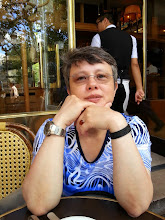"A Seaport", 1644, Claude Lorrain, Oil on Canvas, 103 x 131 cm, National Gallery of London
Calm, beautiful and serene. Seaport, 1644, Italy. Late afternoon. Coastal view. A ship sailing towards the sun. Soon, it will go past the lighthouse at the end of the harbor. On the right-hand side, a full-rigged sailing ship riding the anchor. On the left-hand side, a palace which was inspired by a gateway built in 1570, that led to the Farnese Gardens. Just behind it, the antique Arch of Titus and farther away, another building which draws an imaginary line from the left to right of the painting. To the lighthouse, the fortress partially hidden by the sailing ship. Although, the figures on the painting appear in contemporary dress - unlike most of Claude's later seaport scenes - there are no tangible indications of the era. The clock hand has just stroke five, on the facade of the palace. Time. And the sun, the sea, the people - who will gradually disappear from Claude's later seaport and landscape paintings - but most of all, the light. Claude's light. "Pure as Italian air, calm, beautiful and serene, the work springs forth and with it the name of Claude Lorrain", declared the British painter Turner in 1811. Light and time, and the distance. To the sea. To see...
"A Seaport", by Claude Gellée, known as the Lorrain, from the town of Champagne in the Duchy of Lorraine, who was born in 1600 and died in 1682 in Rome, where he lived almost his entire life. He specialized in ideal landscapes, that often featured classical ruins and pastoral figures, inspired by the Bible or Classical mythology. Claude was a landscape painter, obsessed with the observation of nature and the light effects, at a time when landscape painting was still considered a minor genre, along with still-life painting. Details about Claude's personal life are very sketchy, coming mostly from a few letters he wrote and some of his close friends' memories. Yet, we know for certain that Claude would spend hours lying in the fields, studying the play of light on trees, trying to capture the subtle variations in the air, the atmosphere. We also know that sometimes, Claude would bring along his close friend and painter, Nicolas Poussin (1594-1665). It is said, that each painter influenced the other's style. Perhaps, Poussin encouraged Claude to pay greater attention to his figures? Perhaps, Claude would show Poussin how to look at nature, how to paint the air, how to lay time on the canvas?
How does one lay time on the canvas? Usually, with a path that winds through a valley or a forest, to give the viewer a feeling of temporal dimension. Because most of Claude's seaport as well landscape paintings do not offer a real storia, the feeling of time unfolding before the onlooker's eye, often comes from elsewhere. "A Seaport": the sunlight, so sharp, even at this hour. Claude is the first landscape painter who really succeeded in painting the sun. Not just as a representation, but as a presence. The warmth, on your face. The dazzling beauty of the sun, that would quickly blind you, should you stare at it too long. Yet, there is an overwhelming feeling of harmony and calm. Something is vanishing beyond what the eye can see. The seascape, the light. Something that almost rustles throughout the painting and beyond it. As one goes along towards the sun, a new vision arises. "Les oeuvres de Claude Lorrain naissent de la distance", wrote the German art historian Werner Schade*. Soon, the distance and the light will abolish all possible landmarks. As if, the painter wanted us to perceive nature and time through the depth of his landscapes. To contemplate further away. To enter eternity.
Eternity? Claude's time is a fascinating time. Everything is changing, yet not at the same speed. Galileo advocates for a sun-centered theory. Light is everywhere, in the smallest things and the universe expands far beyond the vision. To see anew. With what eyes? Claude's time is also a traveling time. People embark on longer journeys, to the sea, to other countries, where they discover another quality of light and color. In "A Seaport", the painting is organized according to these new discoveries. The pictorial space like a theatre stage, from which all the painting elements are duly set. The figures on the foreground, the diagonals that converge towards the receding horizon, no longer the limit of the known universe. The ship masts on the right-hand-side and the buildings on the left-hand-side, creating an imaginary wake, a sense of departure. And the sea, mirroring the sky, the atmosphere suffused with a quality of light obtained by subtle aerial gradations. Claude's light, dwelling in the smallest parts of the pictorial space, slowly revealing another dimension of history, of time. Both, so closely entwined. Paradise lost? I went to the seaport, and I saw what I could not see before. I saw the other side of time. The gentle trembling of time. I wanted to go there. Live there. In this magnificent seascape, both intimate and universal. Dans la lumière du soir, la brise légère du partir...
* "Claude Lorrain", Werner Schade, Imprimerie Nationale Editions, 1999, p25













No comments:
Post a Comment